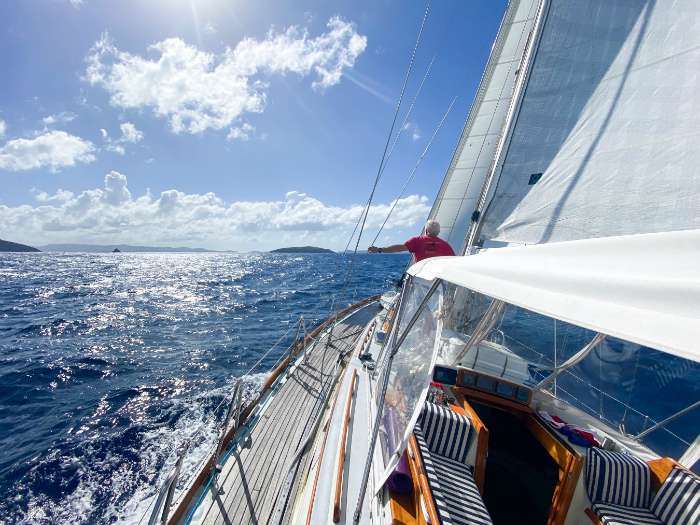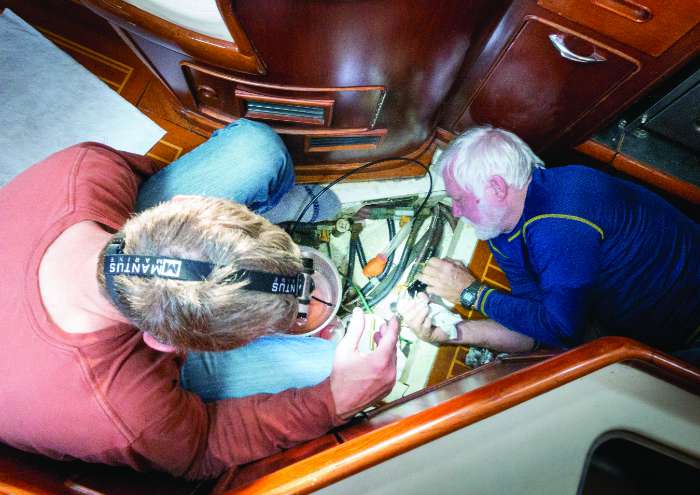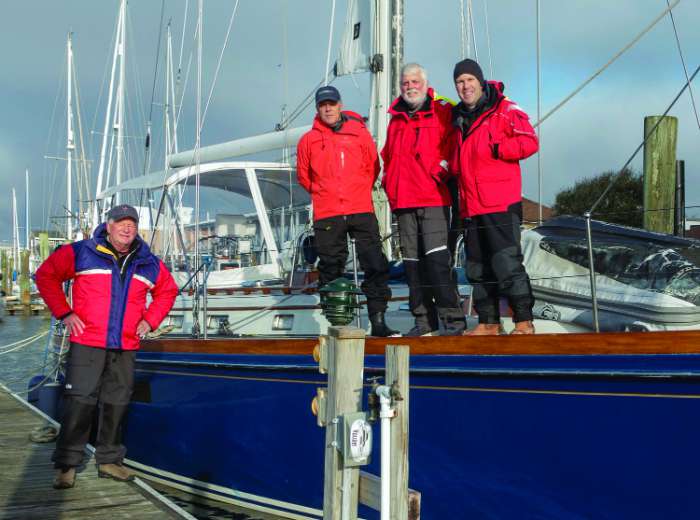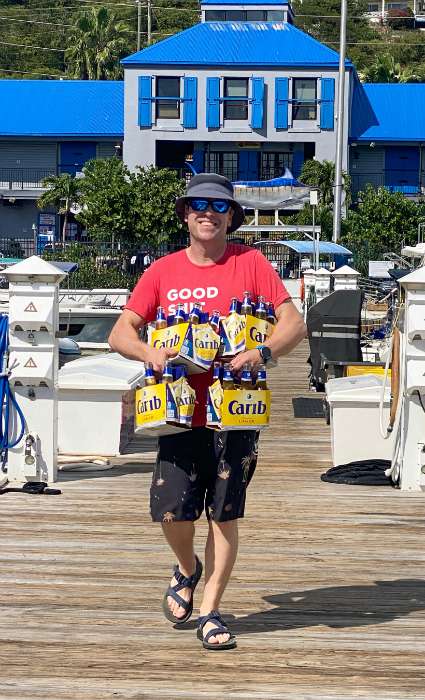Sailing Offshore in the Bermuda Triangle to the USVI in December
Even experienced sailors don’t often get an invitation for an ocean passage. I was thrilled when, after 60-odd years of handling tillers and sheets both as skipper and crew, I was offered to sail the ocean blue. After all, departing the Chesapeake Bay, leaving behind December’s chill on a 1300 nautical-mile jaunt to the savory waters of the Virgin Islands, what could possibly go wrong?
Wildflower, a Little Harbor 54, is a head-turning Ted Hood design displacing 65,000 pounds. With three staterooms, three heads, and a workshop, her functional galley spaciously houses dry, cold, and frozen stores. Her 73-foot mast stepped to the keel/centerboard screams for bluewater just as her carefully crafted teak interior defines an erudite owner.

In early November, I said “yes,” honored to be among four who would make the passage. After weeks of wrestling departure dates, delayed first with engine surprises and then by unsafe weather, we departed Norfolk on December 13, a gray morning with inescapable cold smartly nipping each of us. Surely, I thought, I’d fly home before Christmas.
All four sailors were well-qualified; all had crewed ocean races, and all have owned cruising sailboats. Still, nagging little doubts popped into my head—this was the Bermuda Triangle. I decided to ask Skip Pond, owner and prep school classmate, how many times he’d done this. “This will be my 51st trip to the Islands,” he said calmly. Phew.
I unearthed a packing list developed when crossing the Florida Straits in 2017 and began gathering gear. I updated the list with help from experienced passage sailors, gathered more gear, and shed all that wasn’t vital. Almost overlooked and utterly critical was the last item: a strap-on headlamp that beams red or white.
We departed Norfolk at 0900 on the 13th, needing at once to acclimate to winter’s chill and the incessant motion of the Atlantic as it meets the Bay. Heading east over the Bridge-Tunnel, we had just decided that our first destination was not St. Thomas but Beaufort, NC. Over the next 32 hours, we skirted the west side of the Gulf Stream as we made our way around Cape Hatteras overnight and into the next afternoon. We would arrive just ahead of torrential rain driven by roaring south winds feeding a significant warm storm. I tried not to think about the more than 600 shipwrecks found in those waters. We were easily within reach of a Coast Guard helicopter, right?

The first surprise
Discovered on a routine engine check was the first surprise: a leaking front engine seal coating the engine room with hot oil. To Skip’s significant disappointment, that part had just been replaced. Ashore in Beaufort on Thursday while the storm raged, the crew wiped down the engine room, made possible by three trips to Ace Hardware for cleaners, oil pads, and aluminum cooking trays. We successfully lined the space under and around the engine. We could not stop the leak, of course, and during the passage, we extracted 20-30 ounces of oil from those pans every 10 hours of running, amounting to eight or so times during the trip. We added back fresh oil, usually while the engine was running to maintain boat control.
After a full day’s clean-up effort, we showered and headed to the well-touted Rhum Bar. Time to relax and rest up, even if momentarily, for what was to come.
Literally minutes after an early morning departure from Beaufort Docks Marina, calm waters morphed into roiling seas. For nine days that motion never stopped. Bow up, then down, left then right. Repeat. Repeat. (Dang—I’m still swaying as I type this.)
We met the Gulf Stream at twilight about 60 miles off the coast, hours after land disappeared. At that point, it extends another 60 miles eastward. And, of course, we were headed 165 miles, so we knew we’d be in it for a while.
The Gulf Stream’s wild ride is legendary and that evening it delivered. Big southerly seas from the previous day’s storm mixed with growing northwesterly winds, cooking up a mixing bowl of motion. Seas raged unpredictably from three to 10 feet with swells we couldn’t see coming. We paired up on three-hour watches for a wild night requiring devout attention. As we had done the night before, we were always tethered by night, and when outside the cockpit by day. No exceptions.
Following a watch, the short stint below was, well, short. Doffing the harness, lifejacket, and cold-weather gear was slowed by the boat’s motion, and once in the bunk with lee-cloth tied, those same waves rolled under you. Gently but incessantly, you became nearly weightless. Rest, yes, but there was little sleep. Finally, east of the Gulf Stream a day and half later, 78-degree water allowed us to shed some clothes and transition to two-on, six-off solo watches, allowing some much-needed sleep.

Missing bolts and more surprises
The autopilot was the next surprise. It failed on my watch at 5:15 a.m. on the third day. With everyone asleep, the AP disconnected three times. I attempted twice to set us back on course electronically, but after the third failure, I began hand steering in pure darkness except for the compass.
After just a few minutes, keeping the boat on course wasn’t the issue; I could feel something binding in the steering mechanism. Not good. Thoughts of a steering failure with the boat adrift well outside helicopter range exploded like a lit flare. I rousted the crew, and we sprang into action. It took all four of us. I would lock the steering wheel on course for short periods, another crew relaying “safe to work” messages below to the remaining two who re-assembled the autopilot’s connection to the rudder. Those moving parts would instantly remove a finger if they budged. The guys found the bolt that had fallen free and reinstalled it. Within 30 minutes the “fifth” crew member was back on station. The four human crew members were wide awake and giddy with relief.
The freezer—with its 50 pounds of winter stores—gave up its cooling as the next surprise. Somewhere in the copper lines, the refrigerant had apparently escaped. Skip quickly decided this would be an island-based fix, especially since the crew could be sustained by stores in the refrigerator and dry goods such as peanut butter Oreos. With much prep ashore by Skip, Josh, and their wives, we continued to dine well and thankfully.
Then, there was the water-in-fuel issue. In relative calm and on a whim to check fuel level, we opened the main 150-gallon diesel tank only to discover nearly a gallon of water settled in the bottom. It had likely been there for some time. Still, we taped the fill ports on the deck to prevent sea water from intruding, should that have been the source. The wisdom of having a sizable turkey baster aboard became self-evident. Most of the water was removed and the crisis averted before water reached injectors.
Good advice and blessings
Any such passage requires careful weather planning. Onshore, sailors are good to about three days out and to perhaps 200 nautical miles offshore. Skip took every advantage of talking to longtime friend and well-known weather expert, Chris Parker, via the single sideband (SSB) radio twice daily. There are few reporting weather resources in the Bermuda Triangle, making forecasts challenging. Chris was generally close, but he got one thing absolutely right: he advised us to get south of 24N as soon as possible to avoid storm conditions. We did so, keeping our speed up with engine assist, just missing the southern end of that violent weather system. It later delivered 50-knot winds to much of the East Coast.
In truth, we were incredibly blessed by the weather. We saw just a few short-lived tropical showers over the final days, each hardly enough to wash the well-salted decks. Favorable winds allowed us at first to sail the rhumb line for 800 nm before being headed by winds on the nose. We were forced off to the south-southwest before finally being able to turn east. For 150 nm we continued until reaching 66W, and as many have done before us, found a fabulous close reach in constant 16- to18-knot trade winds down the famed “Route 66” during those final days until finally reaching the Islands.

Despite being out of beer, we were positively giddy on arrival in Red Hook, St. Thomas, USVI. During fuel-up, we discovered we had plenty of diesel remaining. It was a boat new to Skip, so precise fuel burn was unknown. We promptly filled up on beer as well.
After a quick motor around the corner, we tied up in a well-protected slip at Sapphire Beach. After a few hours and multiple rinses to de-salt both the boat and ourselves, we celebrated the fact that while a few things went awry, the boat and crew worked incredibly well. We made it to the islands on a glorious sail. We celebrated Christmas Eve at Sudi’s, a delightful local pub. It proved a fitting prep for re-entry to the lower 48 on Christmas Day for all but Skip who, along with his wife, stayed to enjoy their 13th season aboard in the islands.
I learned that this type of adventure isn’t for everyone and likely not for most recreational sailors. Acclimating to the incessant motion accompanies many fears that emerge during planning and the realization that you must provide your own first aid and initial rescue in an unwelcome event. Upon consideration to the many friends who have asked if I’d do it again, my answer has been a consistent “well, maybe.” #
About the author: Lou Frank grew up sailing and racing in the Annapolis area. After graduation from the University of Maryland, he lived aboard and raced in San Diego while developing media businesses. Decades later, he and his wife now enjoy the Virginia waters of the Bay, enjoying both sail and powerboats. Find him at [email protected].
Find another great offshore sailing article here or search "offshore" in the search bar in the upper righthand side of our website.




